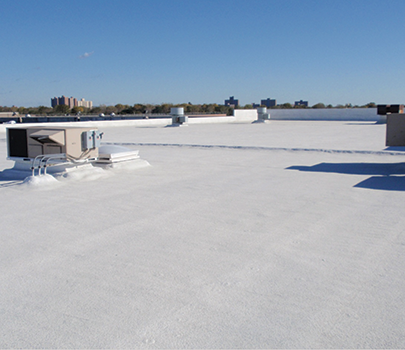
Cool Roofs

Back to Education Center | Roofing Guide
Cool Roof Coatings
At peak temperatures during summer months, the surface of a black roof can easily reach 170ºF, per Oak Ridge National Laboratories. The heat transfers through the roof sheathing via conduction and radiates into the building below, causing the building’s air conditioning units to work harder to maintain interior temperatures, thereby inflating energy bills.
Reflective roof coatings, or cool roof coatings, can lower roof surface temperatures 100ºF, which can reduce the amount of air conditioning needed in buildings and thereby reduce energy bills up to 50%, per Energy Star. The program outlines standards for coating products’ solar reflectance and thermal emittance, which is a material’s ability to release absorbed heat.
Common Coating Materials
- Acrylic
- Silicone
- Urethane
- Butyl rubber
- Polyurea

Urban Heat Islands
Cool roofs can have a particularly favorable impact in urban areas, where the combination of tightly packed buildings and few green spaces can contribute to a phenomenon known as an Urban Heat Island. Building roofs, which are often dark-colored, absorb sunlight and raise ambient temperatures well above what is observed in surrounding suburban and undeveloped areas. The abnormally high temperatures cause the buildings’ air conditioning units to run more often and work harder, resulting in inflated energy bills. The installation of Cool Roofs will cause much of the previously absorbed sunlight to be reflected, thereby lowering ambient temperatures, air conditioner workloads, and energy bills.
Approvals & Specifications
The properties and performance of cool roof coatings can vary greatly, so it’s important to consult established guidelines that outline the standards by which to compare coating products. If a coating has been tested to certain standards and obtained an approval by an authorized organization like the American Society for Testing and Materials (ASTM), proof of approval will be evident on a coating’s packaging or labeling.






